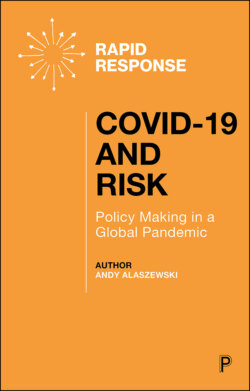Читать книгу COVID-19 and Risk - Alaszewski Andy - Страница 15
На сайте Литреса книга снята с продажи.
Framing COVID-19
ОглавлениеThe ways in which policy makers framed COVID-19 was shaped by their experience of a similar infectious disease: on the western Pacific Rim, the 2002 outbreak of SARS had had an major impact on policy makers and in West Africa, the Ebola outbreak which started in 2013 was still fresh in the memory. In Europe and North America, the regular winter outbreaks of flu shaped the framing of COVID-19.
SARS (Severe Acute Respiratory Syndrome) had similarities to COVID-19: it was a coronavirus which originated in China in 2002 and spread rapidly from mainland China to adjacent territories such as Hong Kong and Taiwan. It was highly infectious and very lethal: nearly 10 per cent of those infected died. Although there was very limited spread of the virus beyond the western Pacific Rim, there was widespread media coverage (Lewison, 2008). By 2003, the SARS outbreak was contained by international cooperation and public health measures: sharing information, isolating the infected and tracing and quarantining their contacts (Horton, 2020).
Ebola is a highly infectious virus. Before 2013, there had been small outbreaks in isolated areas in central Africa with death rates of between 50 and 90 per cent (Honigsbaum, 2020, p. 200). A major outbreak started in Guinea in late 2013 and by early 2014 the virus had spread rapidly to urban areas in neighbouring Sierra Leone and Liberia. While local and international agencies sought to control the outbreak using public health measures, there was resistance from local communities who distrusted these agencies and interpreted measures such as disinfectant spraying as hostile acts designed to spread the virus. The outbreak was brought under control by behavioural changes such as the reduction of intimate contacts in some of the affected communities and by massive international aid. The outbreak was contained mainly in West Africa and was estimated to have infected 29,000 people, killing 11,300 (Honigsbaum, 2020, p. 222).
The SARS and Ebola outbreaks were reported by the media in Europe and North America but they were events that happened in other places and were relatively quickly forgotten. In Europe and North America, influenza was more of an issue. During the winter, flu was an ever-present threat. It was highly contagious and spread rapidly through the population and could be lethal, especially for older people and those with underlying health problems. Most years, levels of infection and deaths were limited and manageable; but in some years, a new more virulent strain would increase infections and deaths and place hospitals under pressure as admissions increased and staffing levels were reduced by staff illness. The most virulent pandemic was the 1918–19 Spanish flu. This pandemic infected around 500 million people and killed 50 million (Jordan, 2019). In Europe and North America, public awareness of flu is maintained by the annual public health campaigns to ensure that vulnerable people receive protective flu vaccinations.
